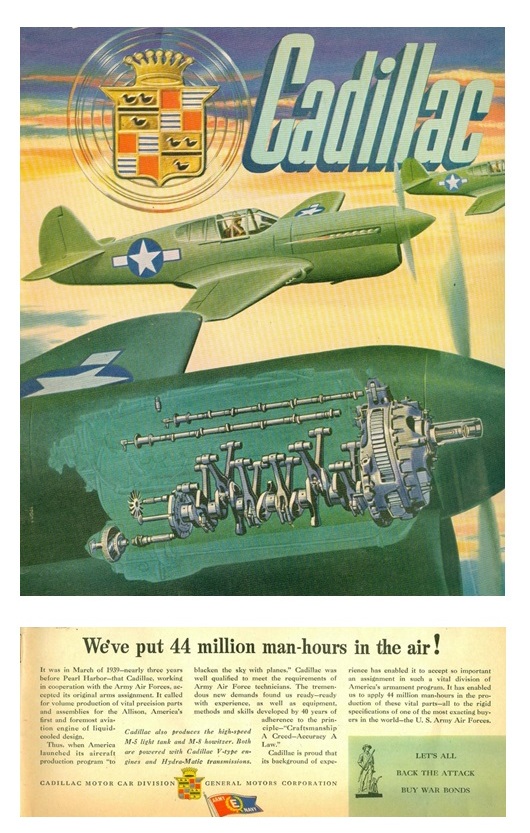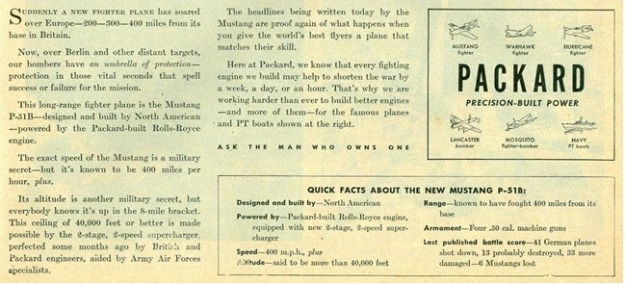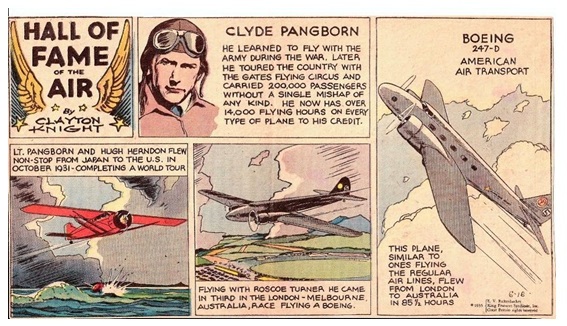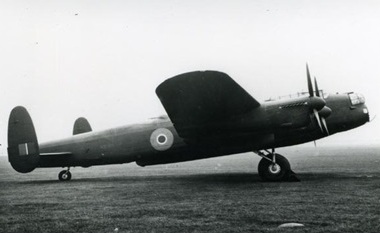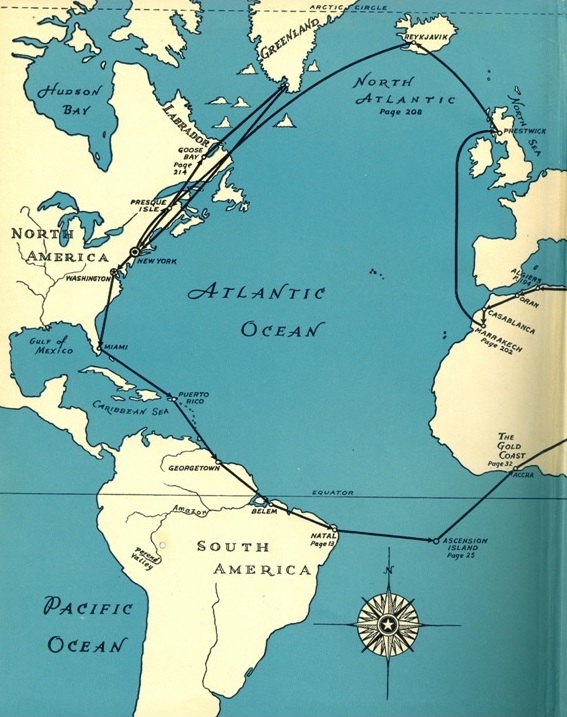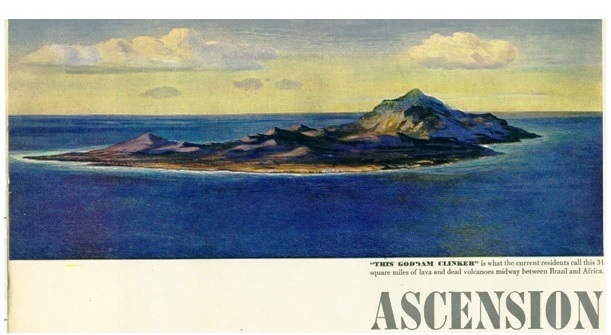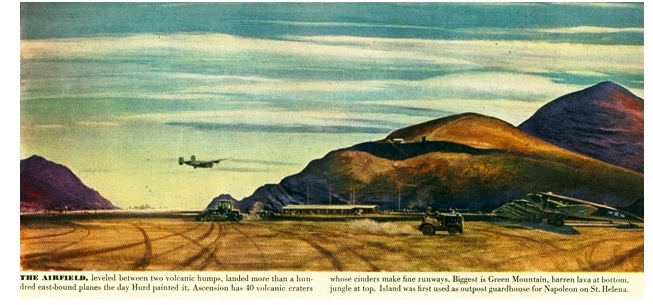Clarence Simonsen’s research on the Lancaster X was published on my main blog Lest We Forget in July 2015. It has been dormant since then until last week. Clarence Simonsen’s research is always well-documented although sometimes it’s quite long to read. But I don’t complain since I believe Preserving the Past is important.
You can refresh your memory by reading again what Clarence wrote in 2015 or read it here on Preserving the Past for the first time…
Research and article by Clarence Simonsen
This classic 1939 British poster celebrates fifty years of British aviation design and aircraft production, as the topless English lady looks to the beginning of her dark war-torn future. The next five war years will bring together the development of British and American aircraft and aero-engines which will effect combatant air forces until the end of the hostilities in May 1945. My story will be told by poster ads used in that time period, also demonstrating how the Canadian built Lancaster Mk. X bomber idea was created and constructed using North American engines and parts.
This pre-war British ad possibly appeared in 1938, when the first production Spitfire Mk. I fighters were delivered to No. 19 and 66 RAF Squadrons. The prototype Spitfire was fitted with the first Rolls-Royce Merlin engine and flew in March 1936, setting a world record of 342 mph [547.2 km/h]. A total of 305 Spitfires were built before the war and over 21,000 during the war years, which appeared in 29 different versions. Over 730 were supplied to the U.S. Army Air Force under reverse “Lend-Lease.” This British aircraft design combined with the Rolls-Royce engine made it a front ranked WWII fighter of all time.
Rolls-Royce Ltd. was established on 15 March 1906, with aero-engine works at Derby, Crewe and Glasgow. They specialized in the production of high performance liquid cooled aircraft engines named the Merlin and Griffon. This 1940 ad promotes the new type Griffon engine which was produced with the outbreak of war in September 1939. This engine was also drawing large interest from the American aviation industry and Government Defense agencies.
In June 1940, the American Secretary of the Treasury, Henry Morgenthau Jr., held discussions with Henry Ford’s son Edsel, regarding the building of the British Rolls-Royce aircraft engine in the Ford Motor Company plant. Edsel tentatively agreed to produce 6,000 Rolls-Royce engines for Great Britain and 3,000 for the United States. In mid-July, Henry Ford called off the entire deal when he refused to manufacture any engines for Great Britain to support their war effort.
LIFE magazine 2 December 1940
The American Defense Advisory Commission subsequently turned to another car manufacturer located in Detroit. In September 1940, an agreement for $130,000,000.00 was signed with the Packard Car Company and this turned out to be a very good choice for the future war effort, Great Britain, the United States and British aircraft manufactured in U.K. and Canada. The Packard built Merlin Rolls-Royce aircraft engines are sometimes confused with the American Packard built Marine engines used in the U.S. Navy PT-Boats.
In 1939, the U.S. Navy contracted the Huckins Yacht Corporation and Electric Launch Company [ELCO] to design three different high speed boats [P.T.] and these were constructed in eight different boats, designated PT-1 to 8. In testing they were found to lack the speed and capabilities the Navy sought. The ELCO company made a trip to England and procured one high speed 70 foot British Hubert Scott-Paine constructed power boat. This British boat was used on an experimental basis and designated PT-9 on 17 June 1940, by the U.S. Navy.
On the left is the British built [Hubert Scott-Paine] experimental PT-9 boat sporting the new Walt Disney designed “Mosquito Fleet”. On the left is Lieutenant Earl S. Caldwell, Chief of Naval Operations in Washington, D.C., the officer who wrote to Walt Disney requesting the new Patrol Torpedo insignia.
The U.S. Navy was pleased with the British design and ordered ten examples to be constructed by ELCO and they were given the designation PT-10 to 19. These new boats were installed with three Packard built Marine gasoline engines of 1,350 horsepower each. These engines were built by Packard’s chief engineer, Jesse Vincent beginning in 1929, and were not part of the British Rolls-Royce contract. The first ten boats were built at Bayonne New Jersey 70′ and the first PT-10 was launched on 20 August 1940. PT-10 was transferred to the Royal Navy on 11 April 1941 and became H.M.M.T.B. 259.
The most famous ELCO constructed boat with Packard Marine engines became Bayonne New Jersey 80′, launched on 20 June 1942 and designated PT-109, skipper John F. Kennedy.
Located by deep-sea explorer Robert Ballard on 22 May 2002, the remains are 1,200 feet down in the South Pacific. Can you imagine the American historical value to this Walt Disney created insignia on PT-109 if it were recovered? This is the second Navy art image which promoted Disney to create a five-man design team which produced over 1,200 insignia during WWII.
LIFE magazine 13 January 1941, shows the very first PT-10 which was launched on 20 August 1940. In eleven months 12 PT Boats will open fire on Japanese attackers at Pearl Harbor and for months later these same boats were the only front line defense against possible Japanese invasion. Packard built over 14,000 Marine 4M 2500 engines, at their East Grand Ave. plant, Detroit, which were not part of the Merlin Rolls-Royce aviation engine built under contract from England.
This early 1941 ad features the P-40 fighter and the PT Boats but the engines were two different designs.
The Packard Car Company began by redrawing all the British blueprints from first-angle projection to American third-angle projection used in the United States, including manufacturing specifications in American terminology. Several significant American improvements were also incorporated into the Packard engines, and a most significant change involved the crankshaft bearing material. This had been developed by General Motors Pontiac Division to prevent the corrosion of auto crankshaft bearings, a common design adapted and used in the manufacture of large American radial aircraft engines.
This ad appeared on 20 April 1942, showing the war production drive of General Motors in America. Lost in this drawing is the fact that the crankshaft bearing material improvement invented by General Motors would make a significant change to the American built Packard aircraft engines. The original British Rolls-Royce crankshaft used a lead bronze with a lead-indium flash finish. Packard engines introduced the General Motors silver with lead-indium flash finish which prevented corrosion from all lubricating oils, even low grade oils. This new bearing coating also improved the break-in time for a new Packard Rolls-Royce engine and boosted the load-carrying ability of the surface, giving the engine a longer life-span.
This ad promotes the American built Allison engine, however it also demonstrates the General Motors invention of the main crankshaft bearings manufacture using silver with a lead-indium flash, which improved the Packard engines.
The first Packard built Rolls-Royce Merlin engine was test run in August 1941, and received the U.S. Army designation V-1650-1 which was equivalent to the Merlin 28 or 29 single stage with a two-speed supercharger.
The early Merlin 28 engines built by Packard were installed in the Kittyhawk Mk. II [P-40F] and the British built Lancaster Mk. I and Mk. III.
The Merlin 28 engines built by Packard were first installed in the Canadian built Hurricane Mk. X aircraft [490 built] constructed by Canadian Car and Foundry Ltd. Later the Packard Merlin 29 engine was installed in the Canadian built Mk. XI, [150 built] Mk. XII and XIIA Hurricane fighters. In total 1,451 Canadian Hurricane aircraft were built, which were also installed with American Nash-Kelvinator Corporation Hamilton Standard propellers that could not accommodate the British spinners. The trade mark Canadian built Hurricanes flew without spinners.
The Merlin 31 Packard built engine [V-1650-1] was first installed in the Canadian built Mosquito Mk. VII aircraft, all of which remained in Canada. The next Canadian model Mk. XX, received the Packard built Merlin 31 and 33 engines, delivered to England in August 1943, and saw action on 29 November 43 attacking Berlin. Later in the war the Packard built Merlin 225 [same as British Merlin 25] was installed in Canadian built Mosquito Mk. 25, Mk. 26, and dual-control Mk. 27 trainer aircraft.
The 1,400 h. p. Merlin 68 [V-1650-3] was installed in the American Mustang P-51B and C models, entering service in early 1943. This long-range fighter could now escort the 8th Air Force deep into Germany, and saved thousands of American lives.
American nose art “Sky Clipper” City of Packard War Workers, on a P-51B donated by the Packard war workers.
The P-51B-NA, serial 43-12484 flew with the 354th Fighter Group, 355th Fighter Squadron.
Due to the tremendous war time production pressures Rolls-Royce faced, particularly in 1940 and 41, the British had been unable to introduce a two-piece cylinder bank into their engine manufacture. Packard became the first to manufacture a two-piece cylinder head and bank assemblies. American manufactured magnetos were used and the AC Delco units were designed to be interchangeable with British counterparts.
Several other important improvements were incorporated into the Packard engines, such as the far superior Bendix fuel injection carburetor. [the British used Skinner’s Union carburetor of Morris Group] The Packard team made a significant change in the redesign of the supercharger drive for the two-stage engines. The epicyclic gearing drive which was patented by Wright Aeronautical was also used on the two-stage engines.
The Packard engines manufactured for Canada and installed in the Hurricane, Mosquito, and Lancaster Mk. X were produced with the standard British propeller shaft used by Society of British Aircraft Constructors.
Thousands of American Packard built Merlin 38 engines [V-1650-1] were installed into the British Lancaster Mk. I & III’s. These were the same as the British Rolls-Royce Merlin 22 with 1,390 h. p. at 3,000 r.p.m. The painting shows No. 44 Squadron Lancaster code KM-T, but the serial is not known. The squadron lost five Lancaster bombers with the code “T”, serial L7548, [17 Apr. 42] W4106, [23 Mar. 43] W4778, [3 Aug. 43] DV331, [21 Dec. 43] and ME699, [5 July 44]. Lancaster PD422 survived the war, off-charge on 14 Dec. 1945.
The superior Bendix fuel injector carburetor and the Bendix “Eclipse” Aircraft Engine Starter were installed in the American P-51 plus the Canadian built aircraft, including the Lancaster Mk. X.
The World War Two historical achievements of the British built Avro Lancaster bomber has been recorded in many books, on film, and today appear on many aviation internet websites. To a lesser extent, the history of the Canadian Lancaster Xs built at Malton, Ontario, by the Victory Aircraft plant tend to be combined with the total production of 7,377 bombers built during World War Two. Last summer, [2014] the Canadian built Lancaster Mk. X serial FM213 [painted as Mynarski Lancaster KB726] made a famous return to England and joined her British built Lancaster cousin. An American pilot-friend [B-25] ask me if the two Lancaster aircraft were in fact manufactured the very same. I informed him the Lancaster Mk. X was totally Canadian production, thanks to the cooperation of “Uncle Sam” and the United States War Industry.
The original design and manufacture of the Canadian Lancaster Mk. X’ were identical to the British Lancaster Mk. III, the first 75 aircraft [KB700 to KB774] received the Packard built [USA] Rolls Royce Merlin 38 engines, which produced 1,390 h.p. at 3,000 r.p.m. Lancaster Mk. X, serial KB775 onwards were installed with the American-Packard Merlin 224 engines. These were manufactured in Detroit by Packard and based on the British Rolls-Royce Merlin 24. They were given the “2” prefix and became the Packard Merlin 224, producing 1,620 h.p. at 3,000 r.p.m.
Altogether during World War Two over 150,000 Merlin Rolls-Royce engines were manufactured in Great Britain and the United States. The Packard Car Company manufactured 55,873 engines in Detroit which were installed in American, British, and British aircraft manufactured in Canada. The Packard engines built for North American Aviation and Curtiss were constructed with the American SAE No. 50 propeller shaft, while the engines supplied to England and Canada were built with the Society of British Aircraft Constructors standard British propeller shaft.
By the fall of 1940, the British still stood alone in the fight against Hitler and the war situation had worsened, which greatly affected the British Aircraft Production Industry. The United States had not yet entered the war, while the Dominion of Canada aircraft production and construction of the British Commonwealth Air Training Plan were still in the early stages. The British urgently needed to speed up aircraft production and place it out of the reach of German bombers. This was all accomplished in a special meeting held in the offices of the British Supply Council in Washington, D.C., on 18 September 1941. The production in Canada of the British heavy bomber [Lancaster] would soon begin, with the official order announced in December 1941. This was combined with a sudden crippling attack by the Japanese on the United States naval and air forces at Pearl Harbor on 7 December 1941, quickly changed the tempo of the world war. The entry of the United States into World War Two would also change the Canadian Lancaster manufacture and parts supply switched from British to North American. In January 1942, the British Lancaster bomber blueprints had arrived at the Aircraft Division of the National Steel Car Corporation at Malton, Ontario. This Aircraft Plant had been constructed for the new [N.S.C.C.] Aircraft Division and opened on 1 February 1938. In 1941, a large extension to the plant was constructed due to a contract to build the American Martin B-26 Marauder bomber. The Marauder contract was cancelled and the Canadian Lancaster Mk. X manufacture took its place. On 25 August 1942, American pilot Clyde Pangborn piloted British built Lancaster Mk. I, serial R5727, from England to Ottawa, [Rockcliffe] Canada, making the first east to west crossing of the Atlantic Ocean by a Lancaster.

This event was reported to American and Canadians in the 28 September 1942 issue of LIFE magazine. The Lancaster first stopped for fuel at Gander, Newfoundland, and then headed to Ottawa, [Rockcliff] where these American photos were taken.


Note the rubber life rafts and survival supplies in the bomb bay of Lancaster R5727 [above] for this first historic Atlantic crossing.
American pilot Clyde Pangborn had a rich aviation history which involved many long distance flights. He was the chief test pilot for Bellanca Aircraft Corporation when the Second World War began. Pangborn officially offered his services to the Allied war effort in 1940 and helped the Royal Air Force establish the early Ferry Command of American aircraft to Great Britain. He piloted the delivery of 175 Atlantic Ocean crossings of British aircraft including the first flight of Lancaster R5727 from England to Rockcliffe, Ontario.

This [American] LIFE magazine photo was taken at RCAF Station Rockcliffe, Ontario, where the Lancaster was demonstrated to RCAF Ottawa high command, including Minister for Munitions and Supply in the Canadian Government, the Right Honourable C.D. Howe. The Lancaster was next flown by pilot Ralph Bell and passenger C.D. Howe to Malton, Ontario, on 31 August 1942.
In September 1942, work began immediately on the new Lancaster production line and R5727 became the master tool and pattern standard aircraft model. This produced a variety of serious [infighting] management problems, which resulted in the National Steel Car Company Aircraft Division being taken over by the Canadian Government. The new Crown Company was renamed “Victory Aircraft” which later [1 December 1945] postwar became A.V. Roe Canada Ltd. or commonly called Avro Canada. British built Lancaster R5727 was later acquired by Trans-Canada Airlines, modified with 10 seats, extra fuel tanks, and began ferrying passengers, air mail, and freight on trans-Atlantic service beginning 22 July 1943.
The initial plans for the building of the Lancaster in Canada begin in early 1942 and involved Sir Oliver of the Churchill War Ministry and Canadian Minister of Munitions and Supply, Hon. C.D. Howe. The British Conservative Coalition Government under P.M. Churchill was formed in 1940 and remained until the elections in 1945. The Churchill War Ministry appointed special members to control the war against Germany in these crucial years of battle. Sir Oliver [below] was appointed the Minister of British War Production in March 1942 and remained in charge until May 1945.
Oliver Lyttelton, 1st Viscount Chandos
On 4 June 1942, Sir Oliver arrived in Washington, D.C. for a special meeting with President Roosevelt and the American Joint War Production board members. On 9 June 42, Sir Lyttelton toured the huge Ford Willow Run B-24 factory and stated -“If Hitler and Goering had made this trip with us through these plants, they would “cut their throats.” The Philco radio company placed this ad in LIFE magazine.
On 16 June 42, Sir Lyttelton departed Washington by train for Ottawa, and a meeting with P.M. Mackenzie King and the Canadian War Production chiefs. At these meetings the details for the building of the Canadian Avro Lancaster Mk. X bomber were formalized. A major challenge was the manufacture of interchangeable parts made in the United States and Canada to that of the British design. While the American built Packard engines high-quality of engineering had been a complete success, other obstacles had to be overcome to build the Lancaster bomber. The manufacture of the Canadian/American parts for the Lancaster can be seen in the following ads.
All Lancaster instruments, radios, ball bearings and a completely new electrical fuselage wiring system came from [North American] Canadian and American companies.
The new novel Canadian wiring system could quickly be converted from a one-wire to a two-wire circuit by pulling out a plug and converting the system, allowing repair and replacement of battle damage without costly repairs being shipped from Canada. Even the Canadian lighting systems were manufactured to be interchangeable with the British production.
The Bendix Aviation Corporation supplied two major improvements for the Packard Rolls-Royce engine plus Lancaster Mk. X precision pilot instruments.
The seats came from New York.
The Canadian Good Year Rubber Company [New Toronto] received the contract to produce the Lancaster Mk. X tires.
Nash-Kelvinator manufactured the Lancaster Mk. X propeller blades.
In March 1941, Nash-Kelvinator was contracted under license [U.S. Government] to build 1,500 Hamilton Standard Hydromantic variable pitch aircraft propellers per month. By 1945, they had built and assembled 158,134 three blade propellers, plus 85,656 spare blades. A large number of these propellers were shipped to England and installed on the British Lancaster bombers. Other propellers were sent to Canada and installed on British built aircraft, including the 430 Lancaster Mk. X aircraft built at Malton, Ontario.
The arrival of KB700 [15 September 1943] and shortly after KB705 [used for component mating tests] allowed the British Ministry of Aircraft Production to test the new Canadian built Lancaster X and all major components were successfully mated with the British counterparts. KB705 went to British Rolls-Royce for testing [interchangeable test] in January 1944. The British were both surprised and impressed with the Canadian workmanship and the joint Canadian/American parts manufacture.
The first production order of 300 Lancaster X’s received the serial numbers KB700 to KB999, produced between August 1943 and March 1945. The first 154 bombers were finished with the gun positions faired over, flown to England where the standard British .303 guns were installed.
The forward turret – two .303 machine guns F.N.5. [Frazer-Nash]
The mid-upper gun turret – two .303 machine guns F.N.50.
The rear gun turret – four .303 machine guns, F.N.20.
During the complete war the British Bombers carried enormous bomb loads combined with highly inflammable aviation fuel, incendiary bombs, and oxygen tanks. The crews flew long hours of combat endurance, only escaping death in seconds by the famous ‘corkscrew’ manoeuvre, which was far inferior to the speedy night-fighter attacks. The aircrew always knew they were outpaced and outmanoeuvred by the German fighters but they also understood they were outgunned by the German fighters, who could stay out of range of the British .303 cal. machine guns [450 yards] and pump 20 m.m. cannon fire into the huge black slow flying bombers. A number of surviving RCAF air gunners expressed the simple cause for the majority of Bomber Command losses was the refusal of the RAF to upgrade to the .50 cal. machine guns. They were sitting ducks.
The Americans took a much different approach and installed a high muzzle velocity and larger caliber machine guns in all their bomber aircraft, giving them a much stronger destructive power, and crew survival.
The most widely manufactured high power upper turret gun used by American aircraft during WWII was the Martin 250 CE-7 to 23 series, which fired twin .50 cal. Browning M2 machine guns. These guns packed a very destructive force and had a full field of fire traversing 360 degrees, with a range of 800 yards.
Lancaster Mk. X. serial KB783 [below] arrived in England in October 1944 and was sent to the Aeroplane and Armament Experimental Establishment at Boscombe Down. This Canadian Lancaster was fitted with the .50 Cal. Martin turret and used for flight gun trials, which proved to be very successful. Due to the new gun weight gain the Martin turret had to be moved further forward to correct the aircraft balance.
Beginning with Canadian built Lancaster Mk. X, serial KB855, [below] the American manufactured twin .50 cal. Martin 250 turret was installed in all the bombers that left the plant in Malton, Ontario.
The Canadian installed Martin 250 CE-23 turret was mounted in the middle of the Lancaster fuselage [in front of roundel] while the old British Frazer Nash 50 was mounted closer to the rear [behind the roundel]. This was due to weight gain, however it also gave much better protection for the complete top of the bomber, which had a 360 degree of fire with two feeds of 800 rounds of .50 cal. ammo. [two ammo boxes on each side, right and left supplied 400 rounds each for a total of 1,600 rounds.
These Canadian Lancaster Mk. X’s were the only RAF bombers to use two .50 cal. machine guns during WWII and this saved many RCAF lives. The range of the British .303 cal. machine gun was best at 450 yards, compared with the .50 cal. American range of 800 yards. Can you imagine the surprise when a German night-fighter pulled into what he believed was a safe distance, then was blasted out of the dark sky by a Canadian Lancaster .50 cal. mid-upper gunner.
Many RCAF veterans believed the Canadian built Lancaster Mk. X manufactured with American Packard engines and North American parts was the safer bomber, and in the case of the mid-upper gunner, it was far more advanced with American .50 cal. fire-power.
LIFE magazine 1944 shows Martin turret fire power.
Update June 2, 2017
Last May I was given many photos with these three that were filled with forgotten memories from the past that I wasn’t aware of. Having spent my childhood and my young adult life in Montreal I was mesmerized by looking at them. I was not born in 1942, but these photos brought great memories from my past.
R5727 had just taken off from Dorval probably to take more fuel having departed from Gander. The date is August 24, 1942. R5727 is heading east towards St-Hubert airport.
It will fly over the St. Lawrence River and Victoria Bridge before heading to RCAF Rockcliffe.
If you have read Clarence’s research you have seen this image.
R5727 was ferried from England. The story is told here in The Gazette.
Clyde Pangborn was the pilot. We already know this from Clarence’s research, but The Gazette lists the crew.

One small detail attracted someone attention…
Jean Claude Charlebois was wondering who was sitting beside the pilot. He wanted to know who he was.

It could only be the Flight Engineer E.G. Longley who would lose his life later in the crash of a Liberator II which ran out of fuel…
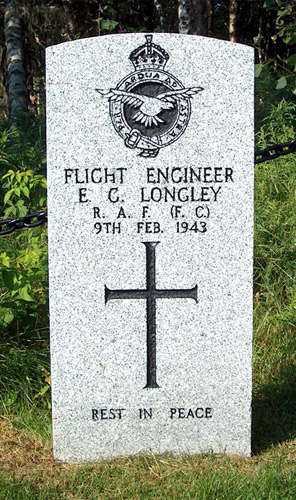
Source
9 February 1943
Liberator II AL591
Return Ferry Service.
Ran out of fuel and crash-landed in a blizzard with sever icing conditions 10 miles north east of Gander, killing nineteen of 21 on board.
Crew and passengers.
F A. Dugan . American civilian. Pilot +
Sgt. J R. Elding. RAF. Pilot +
G P M. Eves. British civilian. Pilot +
T R. Harmes. British civilian. Pilot +
Sgt. H L B. Lewis. RAF. Pilot +
R M. Lloyd. American civilian. Pilot +
Sgt. D J. Owen. RAF. Pilot +
Sgt. G P. Pollard. RAF. Pilot. (Died in hospital)
J. Stagner. American civilian. Pilot +
Sgt. W H. Kyle. RCAF. Navigator +
P/O. R I. Scott. RCAF. Navigator +
F J. Brown. British civilian. Radio Officer +
J D. Jones. British civilian. Radio Officer +
F. Scrafton. Canadian civilian. Radio Officer +
R. Wadsworth. British civilian. Radio Officer +
E G. Longley. Canadian civilian. Flight Engineer +
J B. Merriman, British civilian. Flight Engineer +
I W. Wilmot. Canadian civilian. Flight Engineer +
Lt-Col. L T, Grove. British Army. Passenger +
Survivors Captain R.E. Parker Jr and P/O G.N. Abelson.
Movement history of Liberator II AL591
Construction Number. 89
Operated by the Ferry Command Communications Squadron 20 December 1941- 2 April 1942
Took on Charge Dorval 3 April 1942
To BOAC for the Return Ferry Service.
First Return Ferry Service eastbound to Prestwick 25 July 1942, onward to Cairo on 30 July 1942 returning 6 August 1942.
First Return Ferry service westbound Prestwick – Gander 12 August 1942.
Crash-landed Gander 9 February 1943.
More on the Liberator II here:
http://www.joebaugher.com/usaf_bombers/b24_5.html
More on the crash:
http://www.baaa-acro.com/1943/archives/crash-of-a-consolidated-lb-30-liberator-in-gander-19-killed/
Crash of a Consolidated LB-32-3 Liberator II in Gander: 19 killed
Accident description
- Date & TimeFeb 9, 1943
- Type of AircraftConsolidated LB-30 Liberator
- Operator

- RegistrationAL591
- Flight Phase Landing (descent or approach)
- Flight Type Military
- Survivors Yes
- Site Airport (less than 10 km from airport)
- c/n89
- Location Gander, Newfoundland & Labrador
- Country Canada
- Region North America
- Crew on board6
- Crew fatalities6
- Pax on board15
- Pax fatalities13
- Other fatalities0
- Total fatalities19
- CircumstancesOn final approach to Gander Airport, following a flight from England, the aircraft stalled and crashed 10 miles from the airfield. Two passengers were seriously injured while 19 other occupants were killed.
- CausesAll four engines failed on approach due to fuel exhaustion.












